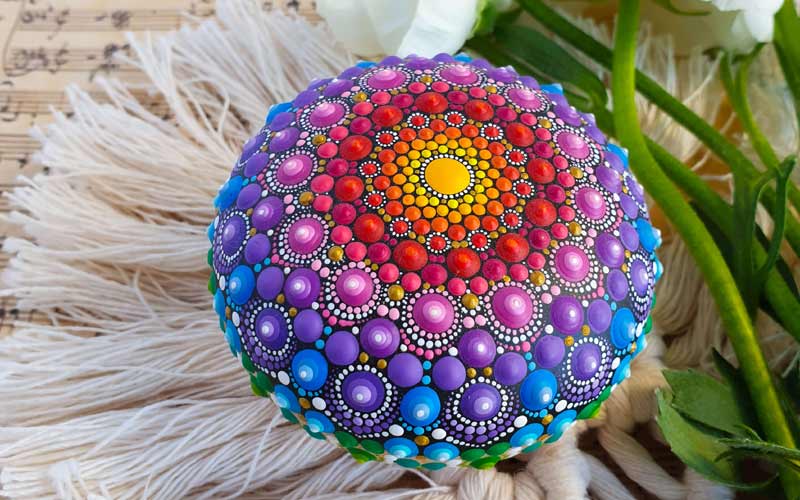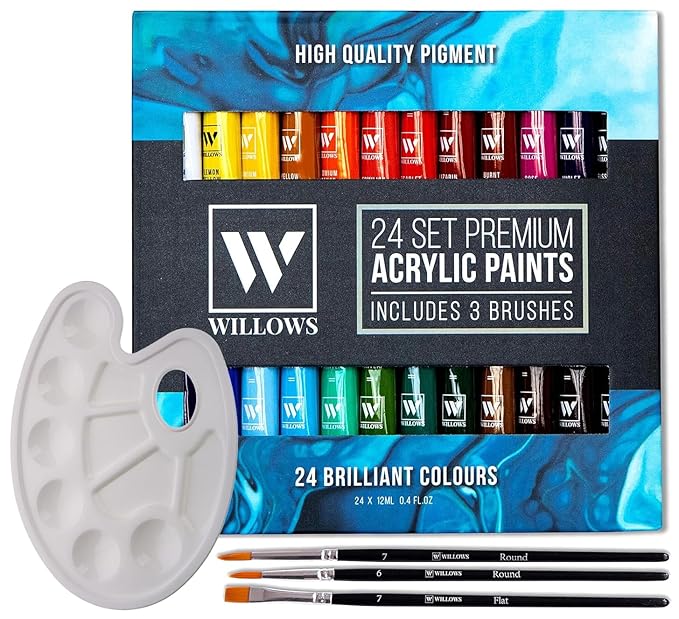
Mandala art on stones can be a lucrative business opportunity due to its unique, handcrafted nature and the growing demand for personalized and spiritual decor items. Here’s how it can be a big earning opportunity:
1. High Demand for Unique, Handcrafted Art Handmade Trend: Consumers are increasingly seeking handmade, unique items over mass-produced goods. Mandala stone art offers something distinct and personalized. Spiritual and Therapeutic Appeal: Mandalas are often associated with spirituality, mindfulness, and meditation. Many people are drawn to them for their calming and centering qualities, which can drive interest in such artwork. Customization: Offering customized designs allows customers to order pieces tailored to their preferences, such as specific colors or patterns.
2. Home Decor and Wellness Market Growing Market for Home Decor: Mandala stones fit well as home decor, especially in spaces dedicated to meditation, yoga, or mindfulness. As people invest more in creating peaceful home environments, these artistic pieces can appeal to them. Wellness and Mindfulness Products: With the wellness industry booming, especially in sectors like meditation and yoga, mandala stones can be marketed as mindfulness tools that bring calm and balance to a space.

3. Low Cost of Materials and Scalability Inexpensive Supplies: Stone canvases are often affordable or even free if collected from nature. The main cost is for paints and sealants, which can be purchased in bulk to keep expenses low. Scalability: Once you master the technique, you can produce multiple pieces in various sizes and styles. As your portfolio grows, you can sell in multiple outlets (e.g., online, art fairs, boutiques).
4. Multiple Sales Channels Online Sales: Platforms like Etsy, Amazon Handmade, and even your own website provide global access to customers who appreciate unique, handcrafted goods. Social Media Presence: Instagram, Pinterest, and Facebook are excellent platforms to showcase your work, connect with customers, and even sell directly. Viral marketing can amplify your reach, especially if you demonstrate the creative process through video content. Local Markets and Art Fairs: Many consumers prefer to buy local and support artisans. Selling at craft fairs, farmer’s markets, or pop-up events in your community can offer direct-to-consumer sales. Collaborations with Boutiques: Partnering with local boutiques, wellness centers, or yoga studios can give you an additional sales outlet.
5. Potential for Premium Pricing Artistic Value: Mandala art, when intricately designed, can be positioned as a premium product, especially if you emphasize its uniqueness, the time involved, and the emotional or spiritual connection. Custom Commissions: Personalized mandala stone art can command higher prices, as customers may want something specific for their space, a gift, or as part of a memorial piece.
6. Workshops and Teaching Opportunities Workshops: You can expand your business by offering mandala art workshops, teaching others how to create their own. These can be done in person or virtually, providing another revenue stream. Online Courses: Platforms like Skillshare or Udemy allow you to create and sell online courses, helping others learn how to create mandala art.
7. Gift Market Gifting Trend: Mandala art stones make great gifts, especially for occasions like birthdays, weddings, and anniversaries. You can tap into the lucrative gift market by creating collections or themed sets. Holiday Sales: Festive designs or special edition pieces (e.g., for Christmas or Thanksgiving) can boost your sales during peak holiday seasons.
By tapping into these multiple revenue streams, mandala art on stone has the potential to turn into a sustainable and profitable business. With strategic marketing, consistent quality, and a focus on consumer needs, it can provide a substantial income.
Mandala art on stone needs some specific type of colors like ceramic colors. Lets see why it is good choice.
Ceramic colors can greatly enhance mandala stone art by offering vibrant, long-lasting, and highly durable finishes. Here’s how ceramic colors contribute to improving mandala stone art:
1. Vibrancy and Depth of Color Bright and Rich Colors: Ceramic paints tend to have a deep, vibrant pigment that stands out against stone. These colors often maintain their brightness even after drying, making the mandala designs more visually striking. Versatility in Shades: Ceramic paints are available in a wide range of shades and finishes, including glossy, matte, or metallic, allowing artists to create diverse effects in their designs.
2. Durability and Longevity Weather-Resistant: Ceramic colors are highly durable and resistant to fading, scratching, and environmental factors like sunlight or moisture. This makes them ideal for mandala art on stones that may be placed outdoors or in more exposed environments. Long-Lasting Finish: The resilience of ceramic paints ensures that the mandala designs stay intact and vibrant over time, contributing to the long-term appeal of the art.

3. Enhanced Detail and Precision Fine Lines and Intricate Patterns: Ceramic paints can be applied in thin, controlled layers, allowing artists to create the intricate, fine details that are often a hallmark of mandala art. This precision is important for ensuring symmetry and complexity in the designs. Smooth Application: Ceramic colors often have a smooth consistency, which can help achieve clean lines and uniform patterns, reducing the risk of smudging or uneven coverage.
4. Suitable for Various Textures Adaptability to Stone Texture: Ceramic paints adhere well to different textures and surfaces, including rough or porous stones. This makes it easier to work with natural stone canvases, providing a solid and smooth finish despite the texture of the base material. Compatibility with Glazing: Ceramic colors can also be paired with glazing techniques for added shine, depth, and protection, further enhancing the visual appeal of the mandala art.
5. Ease of Layering and Blending Layering Effects: Ceramic colors dry relatively quickly and can be layered easily without bleeding or blending together, enabling artists to create complex, multi-layered mandala designs. Blending for Gradients: Artists can blend ceramic paints to achieve subtle gradients, adding depth and dimension to the mandala. This can enhance the aesthetic appeal of the stone art, giving it a more dynamic look.
6. Glossy and Polished Finish Professional Look: When cured, ceramic paints often have a glossy, polished finish that can make the artwork look professionally made. This shiny finish can catch the light and add a beautiful sheen to the mandala patterns, especially in natural light or well-lit spaces.
7. Heat-Resistance and Baking for Enhanced Durability Heat Curing: Ceramic paints can be baked or heat-cured, which further enhances their durability and makes the mandala art highly resistant to external wear and tear. This can be especially useful if the stone art is intended for outdoor use or high-traffic areas. High-Temperature Use: Ceramic colors retain their integrity even under high temperatures, making them ideal for projects that require the stones to be placed near heat sources (e.g., in fireplaces or outdoor patios).
8. Eco-Friendly Options Non-Toxic and Eco-Friendly Paints: Many ceramic paints are non-toxic, which is especially beneficial for artists who want to create eco-friendly mandala art without using harmful chemicals. This can appeal to environmentally conscious consumers.
9. Waterproof and Scratch-Resistant Protection from Elements: Once applied and cured, ceramic paints provide a waterproof and scratch-resistant layer. This makes the mandala stone art suitable for both indoor and outdoor settings, protecting it from rain, humidity, and physical contact. Easy to Clean: Due to their durability, ceramic-painted stones are easy to clean and maintain. Dust or dirt can be wiped off without affecting the paint, ensuring that the art remains fresh and visually appealing over time.
10. Customizable and Flexible Variety of Effects: Ceramic paints allow for customization through techniques like sponging, stippling, or dry brushing, giving artists more creative freedom to experiment with textures and effects. This can help make each mandala piece more unique and personalized. Mixing and Matching: You can mix different colors or types of ceramic paints (e.g., combining metallics with matte colors) to create custom effects that stand out, adding an extra dimension to your mandala designs.
By using ceramic colors in mandala stone art, artists can significantly elevate the quality and appeal of their work, leading to pieces that are more durable, aesthetically pleasing, and versatile, which in turn can help drive higher sales and greater customer satisfaction.
Share : facebook.com twitter.com linkedin.com

